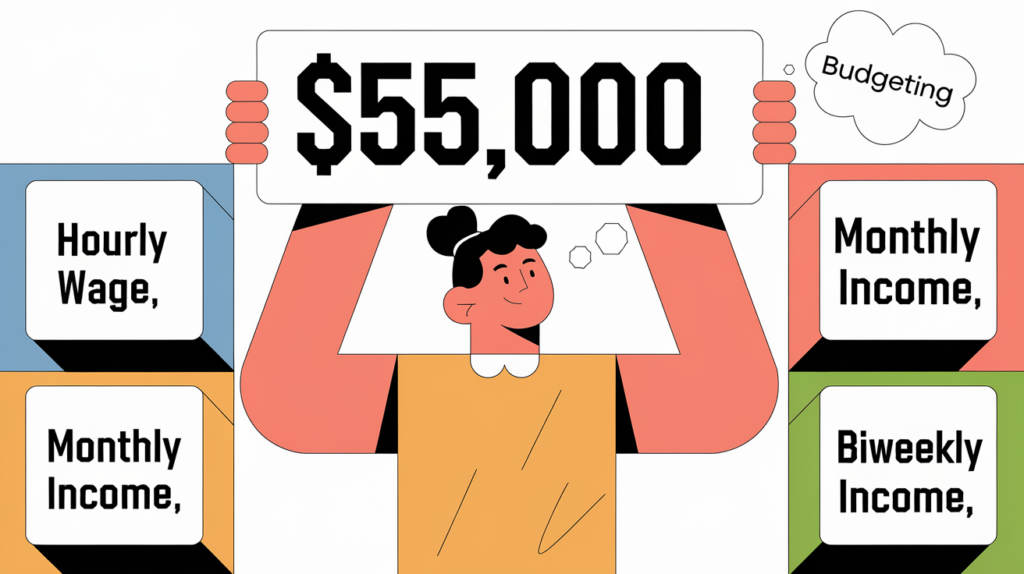Have you ever wondered how your annual salary breaks down into an hourly wage? Whether you’re considering a new job offer or just curious about how your earnings stack up, understanding this conversion can help you make informed financial decisions.
Imagine you’re offered a position with a salary of $55,000 per year. Okay, but what does that actually mean for your day-to-day finances? Let’s dive into the numbers to see how this annual figure translates into hourly, monthly, and biweekly income.
Calculating Your Hourly Wage
A standard full-time work schedule typically includes 40 hours per week. Over a year (52 weeks), that amounts to 2,080 working hours:
40 hours/week × 52 weeks/year = 2,080 hours/yearTo find out your hourly wage, divide your annual salary by the total number of working hours:
$55,000 ÷ 2,080 hours = **$26.44 per hour**So, earning $55,000 a year is equivalent to making approximately $26.44 per hour.
Breaking Down Your Monthly and Biweekly Income
Understanding your monthly and biweekly income can help with budgeting and managing expenses.
Monthly Income:
$55,000 ÷ 12 months = **$4,583.33 per month**Biweekly Income:
If you’re paid every two weeks, you’ll receive 26 paychecks over the year. Alternatively, multiply your hourly wage by the number of hours worked in two weeks (80 hours):
$26.44/hour × 80 hours = **$2,115.20 biweekly (before taxes)**The Role of Taxes and Deductions
It’s important to remember that your take-home pay will be less than your gross income due to taxes and other deductions like health insurance and retirement contributions.
- Federal Taxes: The federal tax rate varies based on your income bracket.
- State Taxes: State income tax rates differ across states. Some states have no income tax at all.
- Other Deductions: Social Security, Medicare, and any benefits you opt into (like a 401(k) plan) will also reduce your net pay.
To get a clearer picture of your take-home pay, consider using an online paycheck calculator that accounts for federal and state taxes, as well as other deductions relevant to your situation.
How Does $55,000 Compare to National Averages?
According to the U.S. Bureau of Labor Statistics, the national average salary in the fourth quarter of 2023 was $59,384 per year. This means a $55,000 salary is slightly below the national average.
However, salaries can vary widely depending on factors like location, industry, and experience level. For instance:
- Geographical Differences: In states like Mississippi, the average income is around $48,000, while in Massachusetts, it exceeds $86,000.
- Cost of Living: Areas with higher average salaries often have a higher cost of living, which can impact how far your salary goes.
Is $55,000 a Good Salary for You?
Determining whether $55,000 is a good salary depends on several personal factors:
- Location: If you live in an area with a low cost of living, $55,000 can provide a comfortable lifestyle. In more expensive cities, it might be more challenging to make ends meet.
- Financial Goals: Consider your objectives like saving for a house, paying off debt, or investing for the future.
- Lifestyle Choices: Your spending habits on housing, transportation, food, and entertainment will affect how far your salary stretches.
Understanding the Living Wage
The concept of a living wage refers to the minimum income necessary for a worker to meet their basic needs, which include housing, food, healthcare, and other essentials. According to a report based on MIT’s Living Wage Calculator, the average salary required to live comfortably in the U.S. is around $68,499 after taxes. This means a $55,000 salary may be sufficient in some areas but might fall short in others, especially in cities with a high cost of living.
You can use the MIT Living Wage Calculator to see how the living wage varies across different locations, which can help you assess how far $55,000 will go in your specific area.
Crafting a Budget That Works
Creating a budget helps you manage your money effectively. Here’s a general guideline on how to allocate your income:
| Category | Suggested Percentage |
|---|---|
| Housing | 25-30% |
| Utilities | 5-10% |
| Food | 10-15% |
| Transportation | 10-15% |
| Debt Payments | 5-10% |
| Entertainment | 5-10% |
| Insurance | 10-25% |
| Savings and Investments | 10-15% |
| Miscellaneous | 5-10% |
Growing Your Financial Future
Building wealth isn’t just about how much you earn—it’s also about how you manage and grow your money.
- Retirement Savings: Contribute to retirement accounts like a 401(k) or IRA. If your employer offers a matching contribution, take full advantage of it. To learn more, check out these resources on Understanding 401(k) Plans and IRA Basics.
- Emergency Fund: Aim to save at least three to six months’ worth of living expenses to prepare for unexpected situations.
- Invest Wisely: Consider low-cost index funds or exchange-traded funds (ETFs) to grow your wealth over time. For more information, you might find this guide on Investing in Index Funds helpful.
Making Informed Financial Decisions
Understanding your earnings in the context of hourly, monthly, and annual figures empowers you to make better financial choices. Keep in mind the impact of taxes and living costs, and don’t hesitate to seek professional advice if needed.
Frequently Asked Questions
How much is $60,000 a year per hour?
$60,000 ÷ 2,080 hours = **$28.85 per hour**What is the annual salary for $30 an hour?
$30/hour × 2,080 hours = **$62,400 per year**How does $55,000 compare to the living wage in the U.S.?
A report based on MIT’s Living Wage Calculator suggests that the average salary required to live comfortably in the U.S. is around $68,499 after taxes. This means a $55,000 salary may be below the comfort threshold in some areas, especially after accounting for taxes.
Need Personalized Financial Guidance?
By breaking down your salary and understanding where your money goes, you’re taking the first step toward financial well-being. Stay informed, make conscious spending choices, and plan for the future you want.
Everyone’s financial situation is unique. If you’re looking for personalized advice on budgeting, taxes, or investments, consider reaching out to a financial professional.
Contact XOA TAX for Expert Assistance:
- Website: www.xoatax.com
- Phone: +1 (714) 594-6986
- Email: [email protected]
- Contact Page: www.xoatax.com/contact-us/




 anywhere
anywhere  anytime
anytime